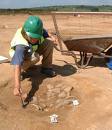Prehistoric settlement uncovered:
An unknown prehistoric settlement has been revealed during archaeological work in East Taunton, Somerset.
7,000-year-old archaeological site in Dresden (Maine, USA) has emerged as one of the most significant finds in New England, and is shaping the way historians view the lifestyles of Archaic period Native Americans. The state historic preservation commission is hoping to purchase the 14.2-acre waterfront site, using grant money obtained through the Land for Maine’s Future Program.
“Since they’ve done some digging, they found that there was a village there, which changes their whole thought process on the early people of this area,” said Richard Lang. “They used to think (Native Americans) were just passing through, and now they think there was a settlement here,” he added. “There are only two other places in New England with village-sized sites from this time period,” said Arthur Spiess, a senior archaeologist with the Maine Historic Preservation Commission. “We thought (Native Americans) lived in small groups moving around the landscape, but it turns out that there’s probably at least a seasonal large group.”
According to documentation filed with Land for Maine’s Future, the site in Dresden is the largest and most intensively occupied site of its age known in Maine.  The site also offered a different vantage point to 7,000 years ago. Since the end of the Ice Age, about 12,000 years ago, water levels have risen to conceal what was a distinct elevation drop on this Kennebec River location. When this site was home to a native village, experts suspect a major falls bridged what is now Dresden with Swan Island.
The site also offered a different vantage point to 7,000 years ago. Since the end of the Ice Age, about 12,000 years ago, water levels have risen to conceal what was a distinct elevation drop on this Kennebec River location. When this site was home to a native village, experts suspect a major falls bridged what is now Dresden with Swan Island.
The dig was commissioned by Somerset County Council before construction begins on the Park and Ride scheme for the Cambria Farm site.
The remains of a prehistoric farm and surrounding fields reveal human occupation from the late Bronze Age to the Roman period (1000 BC to 400 AD).
Construction for the Park and Ride Scheme is set to begin in early 2009.
Councillor Justin Robinson said: “This is a fascinating piece of Taunton’s prehistoric heritage that provides us with a glimpse of everyday life during the Iron Age and helps to fill in the gaps in our knowledge of Somerset’s rural past.”